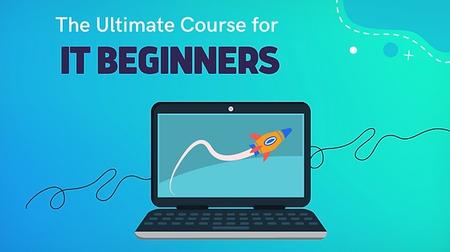
English | MP4 | AVC 1920×1080 | AAC 44KHz 2ch | 83 Lessons (22h 02m) | 3.45 GB
A mini-bootcamp for learning the complete Software Development Life Cycle by taking up all key roles in practice one by one!
Why we created this course
We get a lot of requests from viewers with zero or little IT pre-knowledge, who want to start a career in DevOps.
But since DevOps Engineering is not an entry-level IT profession, we decided to create a course that will prepare non-IT people for transitioning into DevOps.
However, the course turned out to be a great resource for IT beginners in general. By simulating actual real world engineering tasks and going through the complete software development project, it completely dissolves the fear and insecurity of being an IT newbie. No matter if your end goal is to become a software developer, DevOps engineer, cloud engineer etc.
Mini-Bootcamp from Zero to Junior Engineer
The Ultimate Course For IT Beginners The course is for complete IT beginners and our goal with it is to give you an equivalent of a junior engineer’s work experience and know how the whole Software Development Lifecycle (SDLC) works.
This course will give you an important foundational knowledge of software engineering without any knowledge gaps, that sometimes even junior engineers lack. So skills you gain here, will definitely help you stand out!
By the end of this course, you will..
- Have a strong understanding of how the complete software development and release workflow works.
- Better than many junior engineers with actual work experience!
- Know how to write a simple web application with frontend, backend and database.
- Tech Stack: HTML, CSS, JavaScript, Vue.js, Node.js, Express.js, Jest, MongoDB
- Understand basics of infrastructure, servers, operating systems etc, Know how to create and configure a
- virtual server on a cloud platform, and deploy your developed application on it.
Table of Contents
1 Welcome & Course Overview
2 Curriculum
3 How to Access Course Resources
4 Software Development Workflow
5 What is Agile and Scrum
6 Backlog and Scrum Board in Jira
7 Chapter Intro
8 How Websites Work
9 What is JS
10 Variables & Data Types
11 How to Execute JS
12 Conditionals & Comparators
13 Objects
14 Arrays
15 Loops
16 Functions
17 Built-in Functions
18 Intro to HTML & CSS
19 HTML
20 CSS
21 HTML head tags
22 Website with HTML, CSS & JS
23 Chapter Intro
24 Develop Teamable Demo App with HTML, CSS and JS
25 JS Frameworks
26 Maintaining JS Frameworks
27 Open Source Explained
28 Libraries Explained
29 npm Registry
30 Versioning in Software Development Explained
31 How to Use Libraries in JS Application
32 npm CLI
33 Command Line Interface & Operating System Basics Explained
34 Install npm on MacOS
35 Install npm on Windows
36 Install JS Libraries with npm
37 Chapter Intro
38 VueJS Tutorial Part 1
39 VueJS Tutorial Part 2
40 Implement Frontend with HTML, CSS & VueJS Part 1
41 Implement Frontend with HTML, CSS & VueJS Part 2
42 Frontend Backend Communication Explained
43 NodeJS Tutorial
44 Example Frontend Application for NodeJS
45 HTTP, URL & IP Addresses Explained
46 Implement Web Server with NodeJS
47 JSON Explained
48 Implement Data Exchange Between Frontend & Backend
49 Implement Teamable Application Backend with NodeJS
50 Chapter Intro
51 Databases Explained
52 Database Types and Their Usages Explained
53 MongoDB Database, SQL vs NoSQL
54 General Guide to Installing Tools on OS
55 Install MongoDB on MacOS
56 Install MongoDB on Windows
57 General Guide to Connecting Applications to Database
58 Connect Teamable Backend to MongoDB Part 1
59 Connect Teamable Backend to MongoDB Part 2
60 Chapter Intro
61 Test Automation Explained
62 Automated Test Types Explained
63 Write Unit Tests in Jest for Teamable app
64 Write Integration Tests in Jest for Teamable app
65 Chapter Intro
66 Build & Package Teamable Application
67 Running Application from Package/Artifact
68 Chapter Intro
69 Server Basics Explained
70 Systems Administrator Role Explained
71 Create Linux Ubuntu Server on Cloud
72 SSH into Cloud Server from MacOS
73 SSH into Cloud Server from Windows
74 Secure Server with Firewall
75 Configure Linux Ubuntu Server
76 Deploy Application on Linux Server
77 Deployment Stages Explained
78 Development & Deployment Workflow Explained
79 Complete Sprint in Jira
80 Secure MongoDB Database Access
81 Configure Database Access with Credentials in Backend Application
82 Configure Access to Environment Variables in Backend Application
83 Next Steps – Where to go from here?
Resolve the captcha to access the links!